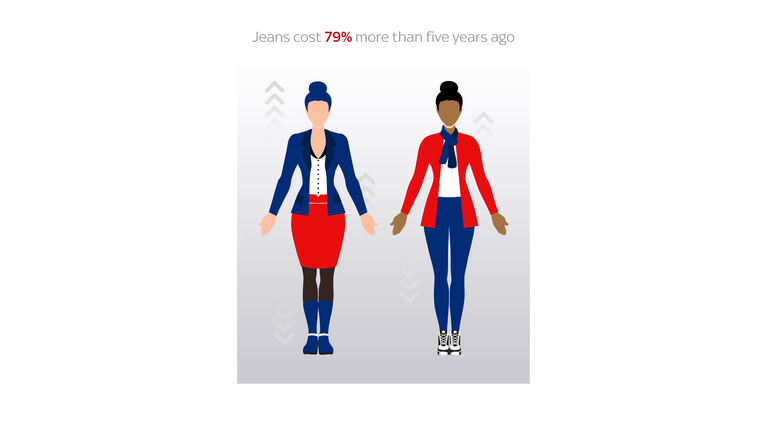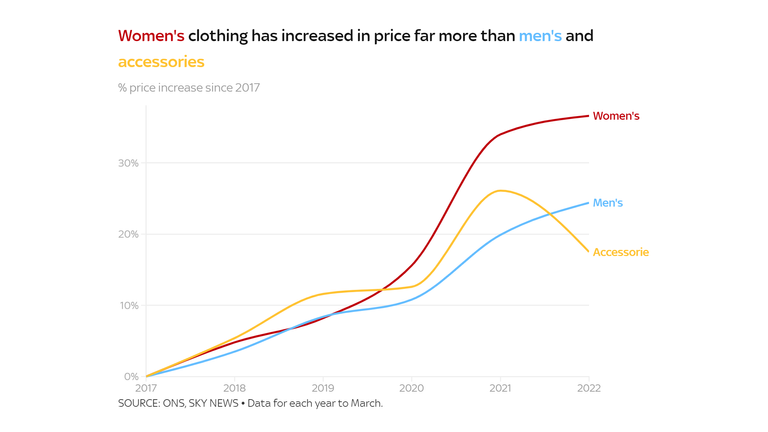Price of women’s clothing increasing much faster than men’s – here’s why
Everyone in the UK is feeling the pinch from rising prices, but the pain is not being felt evenly.
Women face larger price hikes than men in categories like clothing and toiletries, according to Sky News analysis of data from the Office for National Statistics (ONS).
Womenswear prices have increased 37% over the last five years, while menswear has gone up by 25%.
This has far outpaced wages, which are only 20% higher than they were in early 2017.
Explore how much more expensive different items are by clicking on the outfits below.
What about other womenswear? Bras have gone up in price about as much as wages, but knickers are more expensive, costing on average 37% more than five years ago.
The picture for accessories is mixed. Necklaces are cheaper than they were in 2017, but a handbag is 34% more expensive.
Toiletries traditionally bought by women have also experienced blockbuster inflation. Nail varnish and perfume both cost more than 40% more than they did five years ago.
Are retailers discriminating against women?
Rising material costs and supply chain bottlenecks have pushed up the cost of all clothing. So, why have womenswear prices gone up so much more?
Anita Balchandani, senior partner at consultancy firm McKinsey, says it’s because retailers can increase these prices more without losing customers.
“Womenswear has increased well ahead of menswear potentially [as a] result of expectations around demand resilience in the face of price increases,” she says, adding that trends in women’s fashion tend to move on more rapidly as well.
“Typically the womenswear catalogue has a greater share of newness relative to core continuity lines.”
Kayla Marci, market analyst at retail intelligence platform EDITED, says that customers haven’t been deterred by higher prices yet.
“That could be due to the post-pandemic revenge spending phenomenon where, after being indoors and wearing sweatpants for so long, people are meeting up with friends again and looking to buying new outfits,” she says.
Revenge spending fuels demand for jeans and heels
Jeans are one of the items increasing most in popularity since pandemic restrictions lifted.
Buying non-branded jeans will set you back 79% more than it would in 2017, according to ONS data. Branded jeans have seen more moderate price rises.
Ms Marci says that demand for heels and leather is also on the rise, as people switch lockdown loungewear for more fashionable items.
Premium brands are pushing up prices the most. Inflation in the luxury sector is more than 25 times higher than in the mass market, according to data from EDITED.
“Luxury brands have been lifting their prices to offset price increase in raw materials, to become more exclusive and counterbalance poor results during the pandemic,” says Ms Marci.
But as households are increasingly squeezed by rising fuel and food prices, how will demand hold up?
Ms Balchandani says people buying mass-market brands are disproportionately squeezed by price rises in other sectors.
“In the immediate term demand is likely to hold, but further into the year we expect to see some pressure,” she says.
“Optimism is receding – consumer sentiment in the UK is now down to where we were when at the start lockdown.”
The Data and Forensics team is a multi-skilled unit dedicated to providing transparent journalism from Sky News. We gather, analyse and visualise data to tell data-driven stories. We combine traditional reporting skills with advanced analysis of satellite images, social media and other open source information. Through multimedia storytelling we aim to better explain the world while also showing how our journalism is done.


